Much as farmers in East Africa have sought of healing from prolonged drought that has hit the region, the spread of fall armyworm is a new threat that has spread at a rapid stage. At present, fall armyworm has already spread in countries of Rwanda, Ethiopia, Burundi Uganda and has been recently detected in Kenya believed to have spread from Uganda. Kenya’s infected counties include Nandi, Gishu, Uasin, Busia, Bungoma and Transzoia.
Western Kenya was the first region where fall armyworm started from and then spread to other regions. The pest was discovered by the Kenya plant health inspectorate service and Kenya agricultural and live stock research organization in March 2017. Maize producing counties of Bornet, kericho, Nakuru, Baringo in Central Rift as well as Narok in south rift are the most affected by the pest. More still, the pest mainly infects maize at the germinating and tasselling stages of growth after which the crop dries and dies. However, the pest has not affected the coastal and Eastern areas of Kenya.
To prevent the widely spread of fall armyworm, the government of Kenya has put a platform to coordinate the development of intervention strategies to prevent the spread of fall armyworm. More still, farmers have been given extension services along with extensive knowledge and skills on how they can control and manage the spread of the pest.
Zones of Bench-Maji, Kaffa and Sheka in Ethiopia are the best example where interception programs have been put in place to deal with this pest. The health clinic of Mizan told the ministry of agriculture and natural resources of Ethiopia that measures have been for early maize planting in January, February and March.
Additionally, continuous seasons of poor rainfall associated with crop failures, reduced opportunities and water shortage in the horn of Africa have become a serious threat. This has resulted into food insecurity, livestock death, raised food prices and rapidly diminishing access to food by poorhouse holds. Similarly, humanitarian crisis triggered by drought has led to skyrocketing and food insecurity mostly in communities owning livestock.
Also, drought has strongly hit areas of Uganda, Somalia, Kenya, Djibouti, south Sudan, and Kenya, which largely depend on agricultural and livestock production for nutrition, food and income. Also, water sources, rangelands and crops have been scorched by drought, which has in turn caused hunger, disease spread and death of livestock. This has in resulted into the migration of families, selling of their properties and skipping of meals as strategies to cope with the existing situation.
Various technical meeting have been arranged by the food and agricultural organizations to prevent the spread fall armyworm in areas, which have not been affected, and those already affected by the pest. This is in partnership with the governments and other shareholders in southern Africa, the alliance for a green revolution and the international maize and wheat improvement center in Nairobi.
Conclusively therefore, agriculture is the back born of Africa and is the main source of food and employment. Various strategies are recommended for effective management of fall armyworm in all parts of the continent.












